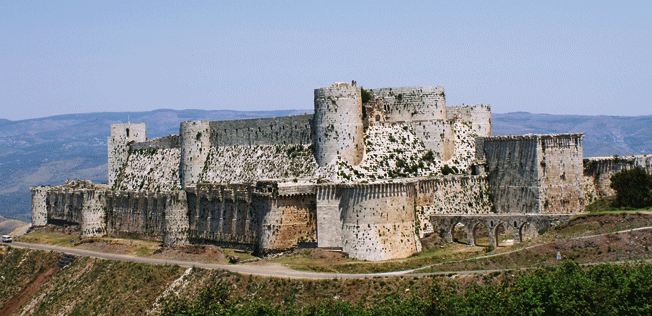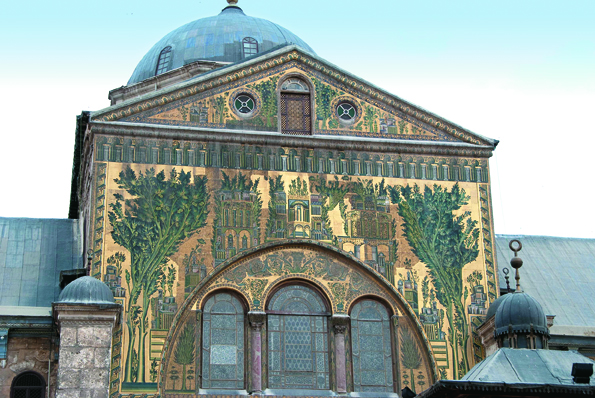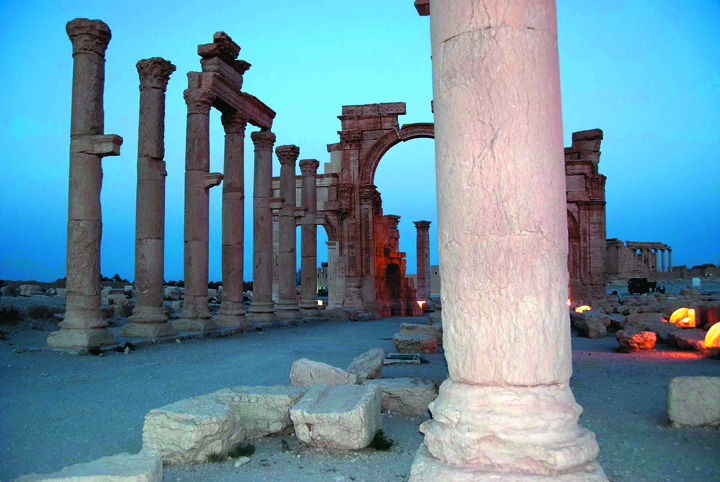
Syria
Total Tourist Experience
 |
We wanted to step back in time without giving up the modern pleasures of good food
and a comfortable hotel. Syria did not disappoint. In a week-long tour of the country
we found an abundance of ancient history to explore
and lodgings where you can feel like a princess.
Written by: Caryle Murphy
Photographs: Molly McCartney
Stand on the parapet of a mighty, 900-year-old fortress to gaze at distant green valleys and mountains once beheld by Crusader knights.
Walk among acres of stone pillars and arches and imagine their original setting--a busy, Silk Road caravan stop brought to ruin because its ambitious queen challenged Rome.
Visit the hilltop where an eccentric Christian misanthrope gained sainthood for the dubious distinction of living atop a pillar for almost 30 years.
History not your passion? What about great shopping and delicious cuisine?
You'll find all of these in Syria, as a friend and I discovered on a week-long visit. We also found a country with one of the friendliest people in the Middle East, and one still relatively unspoiled by crowds of tourists.
But Syria is gradually becoming more integrated with global markets and grooming itself to become a major tourist destination. This is most evident in the growing number of boutique hotels, often fashioned from villas in the older and most atmospheric districts of Aleppo and Damascus. For us, these charming hotels offered the best in Syrian hospitality as well as a peaceful oasis from the urban clang and bustle outside.
My friend Molly and I designed our journey as a circle. Starting in Beirut, we drove north into Syria, where our first stop was Krak des Chevaliers, Qala'at Al Hosn in Arabic. 
This huge, 12th century CE fortress was headquarters of the crusading Knights Hospitaller and is widely regarded as one of the world's best-preserved medieval military constructions. Its outer walls offer amazing, long distance views, and its interior is filled with fascinating still-visible details, including the kitchen's gigantic oven.
Our driver had difficulty finding our next stop but it was worth the trouble. Serjella is one of Syria's so-called 'Dead Cities,' and its 5th century CE churches, tombs, homes, Roman baths and olive oil presses are still discernible in the site's stone ruins.
We reached Aleppo, our first day's destination, in the late afternoon. Also known as Halab, this ancient city has many well-known treasures--for one, the 12th century CE Citadel offering fantastic 360-degree views.
Then there is Aleppo's legendary souq. Not a showpiece recreated for tourists, this teeming market of twisting lanes and crowded stalls is also where Aleppians shop. On nearby streets, scores of tiny shops echo with the sounds of craftsmen making brass and copper products, jewelry, sweets and soap. They hail passing foreigners, inviting them to come in to take a look and a photograph as well.
An afternoon visiting St. Simeon is a must. About an hour's ride from Aleppo, this hilltop site holds the remains of the 5th century CE church built around the stone pillar on which the ascetic St. Simeon gained his fame. Ambling among its tall ruins, you can still feel the grandeur of the building. The restaurant next door, with a breath-taking view of the mountains along Syria's border with Turkey, is a great place to watch the sunset.
Back in Aleppo, dinner means tasting the city's distinctive cuisine, particularly its signature dish of lamb kabob in cherry sauce.
Aleppo is where we stayed in the boutique hotel, Yasmeen d'Alep. Set in a lovingly restored 17th century CE stone villa in the city's Christian quarter, the eight-room hotel is reached by walking through narrow, stone-paved alleys.
Once past its threshold, you feel that you have traveled back in time. Seated by the softly bubbling fountain in the hotel's inner courtyard, you can relax with a cup of tea. The courtyard is also where breakfast is served--a sumptuous feast of figs, jam, cheeses, yogurt, eggs, bread, juice, coffee, fruit and more.
The rooms are beautifully furnished with hand-made, Syrian furniture, much of it inlaid with mother of pearl. And a Turkish bath has been built into the hand-hewn caves underneath the hotel. While Molly got a vigorous scrub, I took advantage of the hotel's free internet link to check my email. 
Our drive to Damascus took us past stunning desert landscapes, farmland, and the urban blight on the outskirts of Damascus. But it ended in another cocoon of enchantment. The Old Vine hotel sits in a 400-year-old Arab villa in Damascus' Old City near Bab Al Faradis, also known as Bab Al Amara.
We slept in the Mushmush (Apricot) room. Large and airy, it was decorated in deep red hues and lit by a huge Arabesque-style chandelier. Some of its windows looked down on the inner courtyard, where guests are encouraged to relax [naps allowed] on the many-pillowed sofas built into the courtyard walls.
As at Yasmeen d'Alep, the staff at Old Vine, which has plans to expand into two neighboring villas, was a valuable resource on what to do and see in Damascus. The city is a tourist's delight and we savored only a few of its attractions. Ummayad Mosque, with its huge marble courtyard, is one of the most famous examples of Islamic architecture. It houses a small shrine said to bear the head of John the Baptist, revered as a prophet by both Muslims and Christians, and next door to the mosque is the grave of Muslim warrior hero Saladin.
We also entered the beautifully decorated shrine to Sayyida Ruqayya. Glistening with light from scores of sparkling chandeliers, the shrine dedicated to the daughter of Imam Al Husein, grandson of Prophet Muhammad (peace be upon him).
And what is there to say about Damascus' vibrant souqs that has not already been said a thousand times? Their sights and sounds and smells and smiles make them an extravagant sensory experience. If you like bargains, this is the place for everything from nuts to carpets to jewels to scarves to trinkets to brass works. And for a delicious end to your shopping, try the hand-made, pistachio-rolled vanilla ice cream from Bakdash's--in business since 1895.
Too soon, it was time to close the circle and head to Beirut's airport for our flights home. As our car inched through the wall-to-wall traffic of the Old City, we said 'masalamah' to Damascus with happy memories of a trip well worth taking.